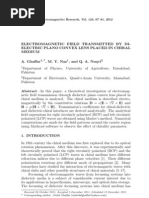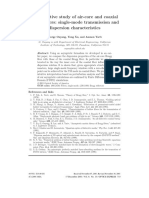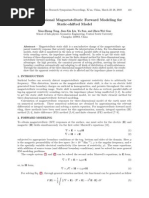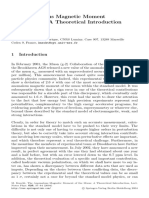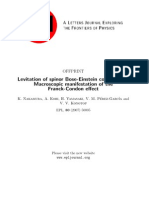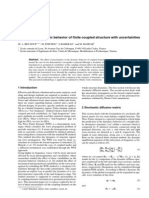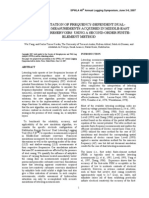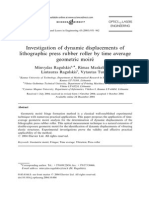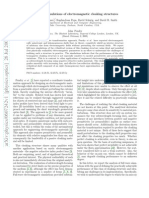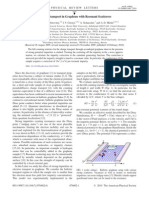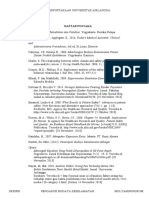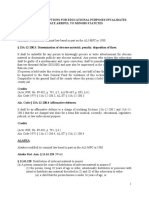Graphene Coupler
Graphene Coupler
Uploaded by
pobio-1Copyright:
Available Formats
Graphene Coupler
Graphene Coupler
Uploaded by
pobio-1Copyright
Available Formats
Share this document
Did you find this document useful?
Is this content inappropriate?
Copyright:
Available Formats
Graphene Coupler
Graphene Coupler
Uploaded by
pobio-1Copyright:
Available Formats
PHYSICAL REVIEW B 88, 045443 (2013)
Nonlinear switching with a graphene coupler
Daria A. Smirnova,
1
Andrey V. Gorbach,
2
Ivan V. Iorsh,
3
Ilya V. Shadrivov,
1
and Yuri S. Kivshar
1,3
1
Nonlinear Physics Center, Research School of Physics and Engineering, Australian National University, Canberra ACT 0200, Australia
2
Centre for Photonics and Photonic Materials, Department of Physics, University of Bath, Bath BA2 7AY, United Kingdom
3
National Research University of Information Technologies, Mechanics and Optics (ITMO), St. Petersburg 197101, Russia
(Received 14 May 2013; published 31 July 2013)
We study nonlinear propagation of electromagnetic waves in two closely spaced graphene layers and
demonstrate that this double-layer graphene waveguide can operate as an efcient nonlinear optical coupler
for both continuous plasmons and for subwavelength spatial optical plasmon solitons. We analyze the
nonlinearity-induced effects of light localization and symmetry breaking in such a graphene coupler, and predict
that the interlayer power-dependent coupling provides a mechanism for optical beam control and manipulation
at realistic input power levels.
DOI: 10.1103/PhysRevB.88.045443 PACS number(s): 78.67.Wj, 42.65.Wi, 73.25.+i, 78.68.+m
I. INTRODUCTION
Graphene is a two-dimensional crystal of carbon atoms,
which exhibits remarkable characteristics.
1
Recently, its
unique optical properties have generated signicant interest
in the research community (see, e.g., Refs. 2 and 3). An
optical response of graphene is characterized by a surface
conductivity which is related to graphenes chemical potential
and Fermi energy. At certain frequencies, graphene behaves
as a metal, and its coupling to electromagnetic waves may
support different types of surface plasmon polaritons, which
are described theoretically
46
and have been already observed
in experiments.
7,8
These features make graphene a promising
material for plasmonics, paving a way towards the develop-
ment of optical metadevices.
9
It was shown that a single graphene layer can sup-
port both transverse magnetic (TM) and transverse elec-
tric (TE) polarized plasmons,
10
and the wave disper-
sion properties can be changed by applying an external
gate voltage. This is the effect behind recently suggested
new types of tunable metamaterial structures based on
graphene.
1114
Nonlinear optical properties of graphene structures have
attracted attention only recently. Large values of nonlinear
optical susceptibilities have been predicted theoretically,
15,16
and recently they were veried experimentally for the third-
order nonlinear response.
17
This nding opens a way for the
exploration of strong nonlinear photonic effects in graphene
structures, including nonlinear self-action of surface plasmons
in graphene
18
and the generation of subwavelength spatial
solitons.
19
In this paper, we study analytically and numerically the
nonlinear propagation of light in two coupled layers of
graphene, and demonstrate that this simple double-layer
structure can operate as an efcient optical coupler for both
continuous plasmon polaritons and for subwavelength spatial
solitons. We demonstrate the nonlinearity-induced symmetry
breaking in this graphene coupler and discuss a physi-
cal mechanism for optical beam control and manipulation.
We show that in order to achieve nonlinear functionality,
graphene should exhibit low loss, and we discuss related
implications.
II. MODEL
We consider a planar structure created by two parallel layers
of graphene, as shown schematically in Fig. 1. We assume that
the surrounding dielectric material is a homogeneous medium
with the dielectric permittivity , and study the nonlinear
propagation of plasmons in the layers. To describe the
interaction of plasmons excited in each layer of our structure,
we generalize the analytical method developed recently in
Ref. 18. We start with Maxwells equations describing the
propagation of monochromatic electromagnetic waves with
the eld dependencies exp(it ),
E = ik
0
H,
(1)
H = ik
0
E +
4
c
[(x +d/2) +(x d/2)] J,
where k
0
= /c is the wave number in free space, is the
angular frequency, and c is the speed of light. We assume
that the graphene layers are placed at x = d/2, as indicated
by Diracs delta functions , with J being the current density
induced in the graphene layers.
In the linear regime, the induced current is proportional to
the tangential component of the electric eld, J = E
, where
(R)
+i
(I)
is a linear frequency-dependent surface con-
ductivity of graphene. Each isolated graphene layer supports
localized surface plasmons with the TM polarization.
4,6
When
losses are neglected, the magnetic eld of these plasmon modes
has the form
H
(0)
1,2
= A
1,2
h
1,2
(x)e
ik
0
z
y
0
, (2)
with the transverse mode prole given by
h
1,2
(x) = ik
0
_
_
e
|xd/2|
_
1, x > d/2,
1, x < d/2,
(3)
where the upper and lower signs correspond to the subscripts 1
and 2 and are associated with the layers located at x = d/2
and x = d/2, respectively (cf. Fig. 1), = k
0
_
2
, and
the normalized wave number is found from the dispersion
relation
2
k
0
_
=
4
(I)
. (4)
045443-1 1098-0121/2013/88(4)/045443(5) 2013 American Physical Society
SMIRNOVA, GORBACH, IORSH, SHADRIVOV, AND KIVSHAR PHYSICAL REVIEW B 88, 045443 (2013)
FIG. 1. (Color online) Schematic of a nonlinear graphene coupler
composed of two layers of graphene. The color pattern demonstrates
how a plasmon beam excited in the top layer tunnels to the bottom
layer (numerical results not to scale). The bottomlayer (which we call
layer 1) and top layer (layer 2) are located in the planes x = d/2
and x = d/2, respectively.
To describe the propagation of nonlinear plasmons in this
double-layer graphene structure, we use the slowly varying
envelope approximation usually employed in the physics of op-
tical solitons.
20
To be more specic, for our problemwe study a
weakly dissipative case when
(R)
(I)
. This dissipation is
low when the frequency of the plasmons and Fermi energy
of graphene satisfy the relations h < 1.67E
F
(
(I)
> 0),
k
B
T E
F
.
21
We also neglect spatial dispersion, which is valid
for h E
F
.
21
To utilize the asymptotic expansion approach, we assume
that (i) nonlinear correction to the conductivity is small, (ii)
waves are localized in the y direction, and their width is such
that diffraction remains weak, and (iii) evanescent coupling
between plasmons excited in different graphene layers is small.
Under these assumptions, the induced current can be taken in
the form
18
J = E
= ( +
NL
|E
|
2
)E
NL
=
3
4
_
3 +
2
_
,
where
3
is the third-order nonlinear conductivity of
graphene.
22
To develop a consistent perturbation theory, we
further assume that in the resulting equations the terms
responsible for the above mentioned effects are of the same
order of smallness. Now we formally introduce a small
parameter ,
2
= max
_
(R)
(I)
NL
|E
|
2
(I)
,(k
0
)
2
,e
k
0
(
2
)d
_
,
and derive the equations for slowly varying plasmon ampli-
tudes. We rewrite Maxwells equations (1) as follows:
E
1,2
= ik
0
H
1,2
,
(5)
H
1,2
= ik
0
E
1,2
+
4
c
(x d/2) (E
1,2
+E
2,1
),
so that the superpositions E = E
1
+E
2
and H = H
1
+H
2
satisfy the original equations. Then, developing a perturbation
theory, the solutions of Eqs. (5) are sought in the form of the
following asymptotic series:
H
1,2y
=
_
A
1,2
(
2
z,y)h
1,2
(x)
+
2
H
(2)
1,2
(
2
z,y,x) +
_
e
ik
0
z
=
_
A
1,2
(z,y)h
1,2
(x) +H
(2)
1,2
(z,y,x) +
_
e
ik
0
z
,
H
1,2z
=
_
H
(1)
1,2
(
2
z,y,x)
+
3
H
(3)
1,2
(
2
z,y,x) +
_
e
ik
0
z
=
_
H
(1)
1,2
(z,y,x) +H
(3)
1,2
(z,y,x) +
_
e
ik
0
z
. (6)
The zero-order term in returns the identity for the
unperturbed plasmons (2)(4). The correction H
(1)
1,2
of the rst
order in is determined from H
1,2
= 0 as
H
(1)
1,2
=
i
k
0
A
1,2
y
h(x).
In the order of
2
we obtain
d
2
H
(2)
1,2
dx
2
+k
2
0
(
2
)H
(2)
1,2
4
c
i
(I)
(x d/2)E
(2)
1,2z
=F
1,2
,
F
1,2
=
_
2ik
0
A
1,2
z
+
2
A
1,2
y
2
_
h
1,2
(x)
+
4
c
(x d/2)(
(R)
+
NL
|A
1,2
|
2
)A
1,2
+
4
c
i
(I)
(x d/2)A
2,1
e
d
, (7)
where
is the derivative of the Diracs delta function, and the
corrections
E
(2)
1,2z
=
i
k
0
H
(2)
1,2
x
(8)
are continuous at x = d/2.
Then, applying the Fredholm theorem,
23
which states
that the solution for the correction H
(2)
1,2
is nondiverging if
the eigenmodes of the homogeneous equation for H
(2)
1,2
are
orthogonal to the perturbation, we nally derive the nonlinear
equations for the slowly varying envelopes A
1,2
of the TM-
polarized plasmons propagating in each layer,
2ik
0
_
A
1,2
z
+ A
1,2
_
+
2
A
1,2
y
2
+g|A
1,2
|
2
A
1,2
= QA
2,1
,
(9)
where
=
2
c
(R)
(
2
)
3/2
k
0
,
g =
4
c
(
2
)
3/2
i
NL
k
2
0
, (10)
Q =
4
c
e
d
(I)
(
2
)
3/2
k
2
0
,
are a linear absorption parameter, and nonlinear and coupling
coefcients, respectively. Remarkably, Eqs. (9), along with
the correct analytical expressions for the effective coefcients
(10), can be obtained in the order O(
2
) of the perturbation
045443-2
NONLINEAR SWITCHING WITH A GRAPHENE COUPLER PHYSICAL REVIEW B 88, 045443 (2013)
expansion by using the substitution
k
0
= k
0
+
_
i
1
2k
0
2
y
2
_
+
in the modied dispersion relation (4), which in the presence
of the second layer takes the form
2
k
0
_
=
4
(I)
i
_
(R)
+
NL
|A
1
|
2
+i
(I)
e
d
A
2
A
1
_
+
_
. (11)
III. NONLINEAR SWITCHING
In the framework of the nonlinear amplitude equations
(9) disregarding losses and beam diffraction, we can analyze
different types of TM-polarized eigenmodes of a nonlinear
double-layer graphene waveguide. For further calculations,
we employ the following expressions for the graphene
conductivity:
10,18,22
=
ie
2
h
_
1
+i
intra
+
1
4
ln
2
2 +
_
, (12a)
3
= i
3
32
e
2
h
(eV
F
)
2
h
2
E
4
F
3
, (12b)
where = h/E
F
,
intra
= h/(E
F
intra
), for the doping level of
E
F
= 0.1 eV, = 1 ( = 2/k
0
12.4 m),
intra
= 10 ps,
24
the Fermi velocity in graphene V
F
c/300, = 4, and take
the separation between the layers as d = 28 nm. We take quite
a large relaxation time and discuss the implications of this
choice below.
We nd that three types of nonlinear modes can propagate
in this double-layer graphene coupler, namely, a symmetric (S)
mode with A
1
= A
2
, an antisymmetric (AS) mode with A
1
=
A
2
, and an asymmetric (A) mode with A
1
= A
2
, similar to
the case of a nonlinear dimer.
25
These modes are presented
in Fig. 2 through their (a), (b) transverse proles and (c)
power-dependent shift of the nonlinear propagation constant.
In the linear regime, only symmetric (S) and antisymmetric
(AS) modes exist. However, above a critical power level, a
symmetry breaking occurs in this nonlinear system when a
different, asymmetric branch (A) emerges, and it describes
the nonlinear states where the power is not distributed equally
between the lower and upper graphene layers. The asymmetric
mode bifurcates at the point p from the antisymmetric
branch, and it is stable, being characterized by a predominant
energy concentration in the vicinity of one of the layers. The
AS mode becomes unstable above the critical power.
Next, we focus our attention on the power-controlled
switching of plasmon beams between the layers and study nu-
merically the propagation of a sech-like input beam launched
into the upper layer (as shown in Fig. 1). The input beam is
selected to be the fundamental solution of a single (uncoupled)
nonlinear equation, and it describes a spatial soliton.
19
For
a peak power density of 6 W/m, the soliton beam width is
about 50 nm. This signicant subwavelength localization is
supported by the large Kerr nonlinearity of graphene.
18,19
0 2 4 6
0
5
10
Guided Power Density (W/m)
k
0
1
)
AS
S
A
p
(c)
14 14
A
(b)
x (nm)
14 14
2
1
0
1
2
AS
S
E
z
(
a
.
u
.
)
(a)
x (nm)
FIG. 2. (Color online) (a), (b) Examples of the transverse mode
proles for symmetric (S), antisymmetric (AS), and asymmetric (A)
modes propagating in the double-layer graphene shown for the E
z
component. (c) Shift of the nonlinear propagation constant vs the
mode power density in the guided plasmon mode propagating in the
z direction. Solid and dashed lines correspond to stable and unstable
branches, respectively.
In Fig. 3, we compare the corresponding switching charac-
teristics of the nonlinear graphene coupler for the continuous
plasmons (whose amplitude is constant along y) (dashed
curve) and for the beams of a nite extent including the soliton
switching (solid curves). The coupler length is selected at the
half-beat length L = /(2Q), when in the linear regime the
input power transfers completely into the second layer.
20
Apart
from an increase of the threshold power density, two regimes
of the coupler operation can be clearly distinguished.
0 2.5 5 7.5 10
0
0.2
0.4
0.6
Input Peak Power Density (W/m)
T
r
a
n
s
m
i
s
s
i
o
n
L
N
FIG. 3. (Color online) Switching characteristics of the nonlinear
graphene coupler. Shown is a fraction of the power transmitted in the
pumped layer for a cw (dashed curve) and soliton input beam (solid
curve) in a half-beat-length coupler as a function of the input peak
power density. Dashed-dotted curve: Calculated relative fractional
output power emerging fromthe other layer in the continuous plasmon
regime.
045443-3
SMIRNOVA, GORBACH, IORSH, SHADRIVOV, AND KIVSHAR PHYSICAL REVIEW B 88, 045443 (2013)
(a)
z
(
m
)
upper layer
0
0.9
1.8
lower layer
(b)
0
0.3
0.6
(c)
y (m)
z
(
m
)
0.2 0 0.2
0
0.9
1.8
(d)
W/m
y (m)
0.2 0 0.2
0
3
6
FIG. 4. (Color online) Spatial distribution of the power density in
the layers of the nonlinear graphene coupler for different input peak
power densities: (a), (b) Linear regime, P
in
= 0.6 W/m and (c), (d)
nonlinear regime, P
in
= 6 W/m, corresponding to the points marked
in Fig. 3 as L and N, respectively.
For relatively small input powers, in the so-called linear
regime, the plasmon beam of the upper layer couples to the
lower layer and tunnels almost completely [see Figs. 4(a) and
4(b)]. For higher values of the input power, the energy transfer
between the layers becomes inhibited, and we observe the
nonlinear regime when the plasmon beamremains in the upper
layer [see Figs. 4(c) and 4(d)]. Importantly, the dissipation
does not inhibit switching but it modies the slope of the
curves and the asymptotic value of the switching curve not
achieving unity, as shown in Fig. 3. Therefore, the beam may
be effectively routed between the graphene layers by changing
its input power.
From the power ow (6 W/m) and knowing the plasmon
structure, we estimate the maximum amplitude of the electric
eld on graphene layer at 7 10
6
V/m, which is below the
graphene breakdown threshold.
26
In our simulations, however,
we assumed low loss graphene, with a relaxation time of
10 ps. Such relaxation times were observed in several works
with multilayer structures,
24,27
however, typical single-layer
graphene reported so far experimentally usually exhibits
relaxation times of the order of 0.1 ps. Such graphene with
higher losses will have a shorter plasmon propagation length,
and it will require larger, and probably unachievable, light
intensities. Therefore, we suggest that high quality, low loss
graphene will potentially be suitable for creating nonlinear
couplers.
Further, we discuss the case when two in-phase beams of
an identical shape are launched into both layers, being shifted
(a)
z
(
m
)
upper layer
0
0.9
1.8
lower layer
(b)
0
0.3
0.6
(c)
y (m)
z
(
m
)
0.2 0 0.2
0
0.9
1.8
(d)
W/m
y (m)
0.2 0 0.2
0
3
6
FIG. 5. (Color online) Plasmon beam routing in the nonlinear
graphene coupler. Spatial distribution of the power density in the
layers of the nonlinear graphene coupler for different input peak
power densities: (a), (b) Linear regime, P
in
= 0.6 W/m and (c), (d)
nonlinear regime, P
in
= 6 W/m.
initially by a half of their width with respect to each other. In
the linear regime, the power exchange between the layers leads
to the effective attraction between the centers of mass of the
beams, as can be seen in Figs. 5(a) and 5(b). However, in the
strongly nonlinear regime the energy exchange is suppressed
and the mutual interaction of optical solitons generated in
the two different layers is accompanied by their repulsion, as
shown in Figs. 5(c) and 5(d).
IV. CONCLUSIONS
We have studied analytically and numerically the propa-
gation of nonlinear electromagnetic waves in a double-layer
graphene structure. We have revealed that this structure can
operate as an efcient planar nonlinear coupler, demonstrating
the switching of light between two different layers of graphene.
We have studied the nonlinear effects in this graphene coupler
for both continuous plasmons and subwavelength spatial
solitons, and described the symmetry breaking and nonlinear
switching with various opportunities for optical beam control
and manipulation at the nanoscale.
ACKNOWLEDGMENTS
The work was supported by the Australian Research
Council, the Engineering and Physical Research Council of
the UK under EP/K009397/1, and the Ministry of Education
and Science of the Russian Federation. The authors thank Y.
Bludov and P. Belov for useful discussions.
1
A. K. Geim, Science 324, 1530 (2009).
2
R. R. Nair, P. Blake, A. N. Grigorenko, K. S. Novoselov, T. J.
Booth, T. Stauber, N. M. R. Peres, and A. K. Geim, Science 320,
1308 (2008).
3
F. Bonaccorso, Z. Sun, T. Hasan, and A. C. Ferrari, Nat. Photonics
4, 611 (2010).
4
F. H. L. Koppens, D. E. Chang, and F. J. G. de Abajo, Nano Lett.
11, 3370 (2011).
5
M. Jablan, H. Buljan, and M. Soljacic, Opt. Express 19, 11236
(2011).
6
A. Y. Nikitin, F. Guinea, F. J. Garcia-Vidal, and L. Martin-Moreno,
Phys. Rev. B 84, 195446 (2011).
7
Z. Fei, A. S. Rodin, G. O. Andreev, W. Bao, A. S. McLeod,
M. Wagner, L. M. Zhang, Z. Zhao, M. Thiemens, G. Dominguez,
M. M. Fogler, A. H. Castro Neto, C. N. Lau, F. Keilmann, and
D. N. Basov, Nature (London) 487, 82 (2012).
045443-4
NONLINEAR SWITCHING WITH A GRAPHENE COUPLER PHYSICAL REVIEW B 88, 045443 (2013)
8
J. Chen, M. Badioli, P. Alonso-Gonzalez, S. Thongrattanasiri,
F. Huth, J. Osmond, M. Spasenovic, A. Centeno, A. Pesquera,
P. Godignon, A. Z. Elorza, N. Camara, F. J. Garca de Abajo,
R. Hillenbrand, and F. H. L. Koppens, Nature (London) 487, 77
(2012).
9
N. I. Zheludev and Yu. S. Kivshar, Nat. Mater. 11, 917 (2012).
10
S. A. Mikhailov and K. Ziegler, Phys. Rev. Lett. 99, 016803 (2007).
11
A. Vakil and N. Engheta, Science 332, 1291 (2011).
12
L. Ju, B. Geng, J. Horng, C. Girit, M. Martin, Z. Hao, H. A. Bechtel,
X. Liang, A. Zett, Y. R. Shen, and F. Wang, Nat. Nanotechnol. 6,
630 (2011).
13
S. H. Lee, M. Choi, T. Kim, S. Lee, M. Liu, X. Yin, H. K. Choi,
S. S. Lee, C. G. Choi, S. Choi, X. Zhang, and B. Min, Nat. Mater.
11, 936 (2012).
14
I. V. Iorsh, I. S. Mukhin, I. V. Shadrivov, P. A. Belov, and Yu. S.
Kivshar, Phys. Rev. B 87, 075416 (2013).
15
S. A. Mikhailov, Europhys. Lett. 79, 27002 (2007).
16
K. L. Ishikawa, Phys. Rev. B 82, 201402 (2010).
17
E. Hendry, P. J. Hale, J. Moger, A. K. Savchenko, and S. A.
Mikhailov, Phys. Rev. Lett. 105, 097401 (2010).
18
A. V. Gorbach, Phys. Rev. A 87, 013830 (2013).
19
M. L. Nesterov, J. Bravo-Abad, A. Yu. Nikitin, F. J. Garcia-Vidal,
and L. Martin-Moreno, Laser Photonics Rev. 7, L7 (2013).
20
Yu. S. Kivshar and G. A. Agrawal, Optical Solitons: From Fibers
to Photonic Crystals (Academic, San Diego, 2003).
21
L. A. Falkovsky and A. A. Varlamov, Eur. Phys. J. B 56, 281
(2007).
22
S. A. Mikhailov and K. Ziegler, J. Phys.: Condens. Matter 20,
384204 (2008).
23
G. A. Korn and T. M. Korn, Mathematical Handbook for Scientists
and Engineers (McGraw-Hill, New York, 1961).
24
T. Otsuji, S. A. Boubanga Tombet, A. Satou, H. Fukidome,
M. Suemitsu, E. Sano, V. Popov, M. Ryzhii, and V. Ryzhii,
J. Phys. D: Appl. Phys. 45, 303001 (2012).
25
J. C. Eilbeck, P. S. Lomdahl, and A. C. Scott, Physica D 16, 318
(1985).
26
M. Currie, J. D. Caldwell, F. J. Bezares, J. Robinson, T. Anderson,
H. Chun, and M. Tadjerb, Appl. Phys. Lett. 99, 211909 (2011).
27
P. Neugebauer, M. Orlita, C. Faugeras, A.-L. Barra, and
M. Potemski, Phys. Rev. Lett. 103, 136403 (2009).
045443-5
You might also like
- 100 Funny QuestionsDocument4 pages100 Funny Questionscityoflte86% (50)
- A Life Well Spent PDFDocument4 pagesA Life Well Spent PDFVishal ShahNo ratings yet
- Progress in Electromagnetics Research, Vol. 123, 67-81, 2012Document15 pagesProgress in Electromagnetics Research, Vol. 123, 67-81, 2012Abdul Razzaq FarooqiNo ratings yet
- Electromagnetic Quantum-Size Effects in Directional Near-Field EELS of NanocrystalsDocument4 pagesElectromagnetic Quantum-Size Effects in Directional Near-Field EELS of NanocrystalsemediageNo ratings yet
- Band StructureDocument9 pagesBand StructurelolaNo ratings yet
- Effect of Anisotropic Environment On Near Field Optical Properties of Trimer Nano CylindersDocument11 pagesEffect of Anisotropic Environment On Near Field Optical Properties of Trimer Nano CylindersjeslyjacobassumptionNo ratings yet
- Direct and Inverse Scattering For Transient Electromagnetic Waves in Nonlinear MediaDocument25 pagesDirect and Inverse Scattering For Transient Electromagnetic Waves in Nonlinear Medianetscape10No ratings yet
- Inducing A Magnetic Monopole With Topological Surface StatesDocument9 pagesInducing A Magnetic Monopole With Topological Surface StatesMike WestfallNo ratings yet
- Open Source, Heterogeneous, Nonlinear OpticsDocument11 pagesOpen Source, Heterogeneous, Nonlinear OpticsalejandrofedeNo ratings yet
- Progress in Electromagnetics Research, Vol. 132, 149-158, 2012Document10 pagesProgress in Electromagnetics Research, Vol. 132, 149-158, 2012程宇凡No ratings yet
- Analysis of EMG Waves From A Pulse Source: RL Il JK ×R TL Il JK ×RDocument5 pagesAnalysis of EMG Waves From A Pulse Source: RL Il JK ×R TL Il JK ×RArun KumarNo ratings yet
- CH 10Document25 pagesCH 10Mohammed AliNo ratings yet
- Lande G FactorDocument9 pagesLande G FactorPartha SenguptaNo ratings yet
- Tuning Nonlocal Effects in Grooved Cylindrical Plasmons by H - 2023 - Results inDocument5 pagesTuning Nonlocal Effects in Grooved Cylindrical Plasmons by H - 2023 - Results inronaldquezada038No ratings yet
- Brigadnov 2005Document14 pagesBrigadnov 2005Iván Amaury S DNo ratings yet
- An Analytic Solution To The Scattering Fields of Shaped Beam by A Moving Conducting Infinite Cylinder With Dielectric CoatingDocument5 pagesAn Analytic Solution To The Scattering Fields of Shaped Beam by A Moving Conducting Infinite Cylinder With Dielectric CoatingDyra KesumaNo ratings yet
- Effective Action and Renormalization Group Flow of Anisotropic SuperconductorsDocument19 pagesEffective Action and Renormalization Group Flow of Anisotropic SuperconductorssatyabashaNo ratings yet
- Progress in Electromagnetics Research, PIER 94, 351-366, 2009Document16 pagesProgress in Electromagnetics Research, PIER 94, 351-366, 2009Abdul Razzaq FarooqiNo ratings yet
- Comparative Study of Air-Core and CoaxialDocument15 pagesComparative Study of Air-Core and CoaxialajaykumarNo ratings yet
- Abd8758 SMDocument16 pagesAbd8758 SMhanrong912No ratings yet
- Effective Mass in Bilayer Graphene at Low Carrier Densities - The Role of Potential Disorder and Electron-Electron InteractionDocument5 pagesEffective Mass in Bilayer Graphene at Low Carrier Densities - The Role of Potential Disorder and Electron-Electron InteractionfelicioNo ratings yet
- Nanoradar Based On Nonlinear Dimer NanoantennaDocument3 pagesNanoradar Based On Nonlinear Dimer NanoantennamenguemengueNo ratings yet
- Three-Dimensional Magnetotelluric Forward Modeling For Static-Shifted ModelDocument4 pagesThree-Dimensional Magnetotelluric Forward Modeling For Static-Shifted ModelSiti Reiwanti AuliyaniNo ratings yet
- Effect of Strong Magnetic Fields On The Pasta Phase StructureDocument8 pagesEffect of Strong Magnetic Fields On The Pasta Phase Structuremevlut46No ratings yet
- Determination of Surface Tension Coefficient of Liquids by Diffraction of Light On Capillary WavesDocument10 pagesDetermination of Surface Tension Coefficient of Liquids by Diffraction of Light On Capillary WavesFikry AdiyansyahNo ratings yet
- Plasmon-Polaritons and Their Use in Optical Sub-Wavelength. Event of Copper and SilverDocument7 pagesPlasmon-Polaritons and Their Use in Optical Sub-Wavelength. Event of Copper and SilverIJRAPNo ratings yet
- Directional CouplersDocument14 pagesDirectional CouplersAhmed AliNo ratings yet
- Propagation of Love Waves in An Elastic Layer With Void PoresDocument9 pagesPropagation of Love Waves in An Elastic Layer With Void PoresAnshul GroverNo ratings yet
- Computation of Dyadic Green's Functions For Electrodynamics in Quasi-Static Approximation With Tensor Conductivity PDFDocument16 pagesComputation of Dyadic Green's Functions For Electrodynamics in Quasi-Static Approximation With Tensor Conductivity PDFnbhyblijunNo ratings yet
- Muon Amm TheoryDocument48 pagesMuon Amm TheoryTony HartinNo ratings yet
- Unified Solver MethodDocument10 pagesUnified Solver MethodMustafa mızrakNo ratings yet
- Plasmonic Physics of 2D Crystalline MaterialsDocument30 pagesPlasmonic Physics of 2D Crystalline Materials유재원No ratings yet
- K.L. Shuford Et Al - Finite-Difference Time-Domain Studies of Light Transmission Through Nanohole StructuresDocument8 pagesK.L. Shuford Et Al - Finite-Difference Time-Domain Studies of Light Transmission Through Nanohole StructuresGomsajNo ratings yet
- An Exact Solution of The Cylindrical WaveDocument13 pagesAn Exact Solution of The Cylindrical WavekrejishNo ratings yet
- Polar EigenstatesDocument11 pagesPolar EigenstatesPeter MuysNo ratings yet
- S. Wuster, T.E. Argue and C.M. Savage - Numerical Study of The Stability of Skyrmions in Bose-Einstein CondensatesDocument8 pagesS. Wuster, T.E. Argue and C.M. Savage - Numerical Study of The Stability of Skyrmions in Bose-Einstein CondensatesPomac232No ratings yet
- K. Nakamura Et Al - Levitation of Spinor Bose-Einstein Condensates: Macroscopic Manifestation of The Franck-Condon EffectDocument8 pagesK. Nakamura Et Al - Levitation of Spinor Bose-Einstein Condensates: Macroscopic Manifestation of The Franck-Condon EffectPomac232No ratings yet
- Variability of Dynamic Behavior of Finite Coupled Structure With UncertaintiesDocument4 pagesVariability of Dynamic Behavior of Finite Coupled Structure With UncertaintieswalhalassaadNo ratings yet
- Wei - Paper For PetrophysicDocument13 pagesWei - Paper For Petrophysicyangwei00414312No ratings yet
- InTech-Propagation of Electromagnetic Waves in Thin Dielectric and Metallic FilmsDocument22 pagesInTech-Propagation of Electromagnetic Waves in Thin Dielectric and Metallic FilmsCarlos Humberto CostaNo ratings yet
- Spin Imbalance in Hybrid Superconducting Structures With Spin-Active InterfacesDocument5 pagesSpin Imbalance in Hybrid Superconducting Structures With Spin-Active InterfacescrocoaliNo ratings yet
- NLP ProblemsDocument26 pagesNLP ProblemsTianyu TaoNo ratings yet
- First Principles Theory of The EPR G-Tensor in Solids: Defects in QuartzDocument5 pagesFirst Principles Theory of The EPR G-Tensor in Solids: Defects in Quartzfghsda123000No ratings yet
- Full-Wave Analysis of Nanoscale Optical TrappingDocument4 pagesFull-Wave Analysis of Nanoscale Optical TrappingmarkrichardmuradNo ratings yet
- Nonlinear WaveguidesDocument11 pagesNonlinear WaveguidesScientist AkaiNo ratings yet
- Analisis de Un Espectro de Infrarojo en Una Molecula DiatomicaDocument6 pagesAnalisis de Un Espectro de Infrarojo en Una Molecula DiatomicaMAR�A F�TIMA COASACA CAMACHONo ratings yet
- Investigation of Dynamic Displacements of Lithographic Press Rubber Roller by Time Average Geometric MoireDocument12 pagesInvestigation of Dynamic Displacements of Lithographic Press Rubber Roller by Time Average Geometric Moirecharles_boyle_3No ratings yet
- Full-Wave Simulations of Electromagnetic Cloaking StructuresDocument5 pagesFull-Wave Simulations of Electromagnetic Cloaking StructuresRamin FarzanehNo ratings yet
- Waveguide Propagation PDFDocument43 pagesWaveguide Propagation PDFGECM85No ratings yet
- Informe Final PlasmonesDocument5 pagesInforme Final Plasmonesdolmanc666No ratings yet
- Mobility Enhancement in Heavily Doped Semiconductors Via Electron Cloaking - SupplementaryDocument17 pagesMobility Enhancement in Heavily Doped Semiconductors Via Electron Cloaking - Supplementary呂衍德No ratings yet
- Marti 2012DarwinReviewDocument40 pagesMarti 2012DarwinReviewah.afsharrNo ratings yet
- Charge Transport in Graphene With Resonant Scatterers: Week Ending 19 FEBRUARY 2010Document4 pagesCharge Transport in Graphene With Resonant Scatterers: Week Ending 19 FEBRUARY 2010Iván RoaNo ratings yet
- L. Zamora-Peredo Et Al - Preliminary Evalutation of Quantum Hall Effect Devices by Photoreflectance SpectrosDocument5 pagesL. Zamora-Peredo Et Al - Preliminary Evalutation of Quantum Hall Effect Devices by Photoreflectance SpectrosGreamxxNo ratings yet
- bk978 0 7503 5552 0ch9Document24 pagesbk978 0 7503 5552 0ch9Aaiesha MohammedNo ratings yet
- 5.semi - IJSST - Digital Parameters - C. Chettah - Algeria - OPaidDocument6 pages5.semi - IJSST - Digital Parameters - C. Chettah - Algeria - OPaidTJPRC PublicationsNo ratings yet
- Bielajew Salvat 2001Document12 pagesBielajew Salvat 2001jiar001No ratings yet
- Sheng APB 03Document8 pagesSheng APB 03Gabriel Flores AlfaroNo ratings yet
- 2016 Current Flow Paths in Deformed Graphene From Quantum Transport To Classical Trajectories in Curved Space MIRAR IMPORTANTEDocument16 pages2016 Current Flow Paths in Deformed Graphene From Quantum Transport To Classical Trajectories in Curved Space MIRAR IMPORTANTEantosanNo ratings yet
- Molecular Mechanisms in Materials: Insights from Atomistic Modeling and SimulationFrom EverandMolecular Mechanisms in Materials: Insights from Atomistic Modeling and SimulationNo ratings yet
- Electron Beam-Specimen Interactions and Simulation Methods in MicroscopyFrom EverandElectron Beam-Specimen Interactions and Simulation Methods in MicroscopyNo ratings yet
- PHAN Catalogue EN 2018Document2 pagesPHAN Catalogue EN 2018anhhp8xNo ratings yet
- USA Harvard MIT Mathematics Tournament 2014 139Document12 pagesUSA Harvard MIT Mathematics Tournament 2014 139Oki VnnNo ratings yet
- Lagu Bahasa InggrisDocument4 pagesLagu Bahasa InggrisReynaldi OktovalNo ratings yet
- This Document Is A Preview Generated by EVS: Eesti StandardDocument8 pagesThis Document Is A Preview Generated by EVS: Eesti StandardMárcio BussNo ratings yet
- The Integrating A/D Converter (ICL7135) : Application Note February 1999Document5 pagesThe Integrating A/D Converter (ICL7135) : Application Note February 1999ytnateNo ratings yet
- Zweber CV 2024Document4 pagesZweber CV 2024api-632375384No ratings yet
- IrosunDocument2 pagesIrosunJesus Rodriguez100% (3)
- Redbus Bus Tickets FormatDocument8 pagesRedbus Bus Tickets FormatFrancis ThazhuthaNo ratings yet
- 1st Putnam 1938Document2 pages1st Putnam 1938Võ Thượng AnhNo ratings yet
- Dear Parish Priest/Church MemberDocument16 pagesDear Parish Priest/Church MemberStaffan EnbomNo ratings yet
- Sports Tourism A New Paradigm Shift in The Tourism Industry of AssamDocument5 pagesSports Tourism A New Paradigm Shift in The Tourism Industry of AssamarcherselevatorsNo ratings yet
- SPECTRAL THEORY AND ITS APPLICATIONS Boo PDFDocument174 pagesSPECTRAL THEORY AND ITS APPLICATIONS Boo PDFDaniel Da Costa SilvaNo ratings yet
- Aryan InvasionDocument6 pagesAryan InvasionNamdev RavkaleNo ratings yet
- Report On The Stage 3-4 Salvage Excavation of The Alexandra SiteDocument299 pagesReport On The Stage 3-4 Salvage Excavation of The Alexandra SiteT.O. Nature & DevelopmentNo ratings yet
- TrafficDocument114 pagesTrafficCarl S FranciscoNo ratings yet
- Taking God SeriouslyDocument11 pagesTaking God SeriouslyFavela777No ratings yet
- Ecocriticism Sample Research ResultsDocument1 pageEcocriticism Sample Research ResultsAnonymous FHCJucNo ratings yet
- Chapter 17 Indian Constitution - Fundamental Rights and DutiesDocument3 pagesChapter 17 Indian Constitution - Fundamental Rights and Dutiesaaqibyt004No ratings yet
- Brien 9780195594027 SCDocument17 pagesBrien 9780195594027 SCFredrick KabojaNo ratings yet
- SaraDocument19 pagesSaraAYMEN GOODKidNo ratings yet
- 20 DAFTAR PUSTAKA - DikonversiDocument6 pages20 DAFTAR PUSTAKA - DikonversiSeppina DwinNo ratings yet
- Course Plan HCIDocument9 pagesCourse Plan HCISathyanarayananNo ratings yet
- Lab Report 1Document3 pagesLab Report 1Abdul Munim100% (1)
- Daily Dairy 23-10-2023Document3 pagesDaily Dairy 23-10-2023Afaq AhmedNo ratings yet
- My ParentsDocument2 pagesMy ParentsA personNo ratings yet
- Fashion and ClothingDocument5 pagesFashion and ClothingGalvan VinNo ratings yet
- 2016 Physics Questionbank - BookDocument454 pages2016 Physics Questionbank - Bookdencos2006No ratings yet
- Obscenity Exemptions For Educational Purposes Invalidates State Harmful-to-Minors StatutesDocument69 pagesObscenity Exemptions For Educational Purposes Invalidates State Harmful-to-Minors StatutesJudith Reisman, Ph.D.100% (4)


